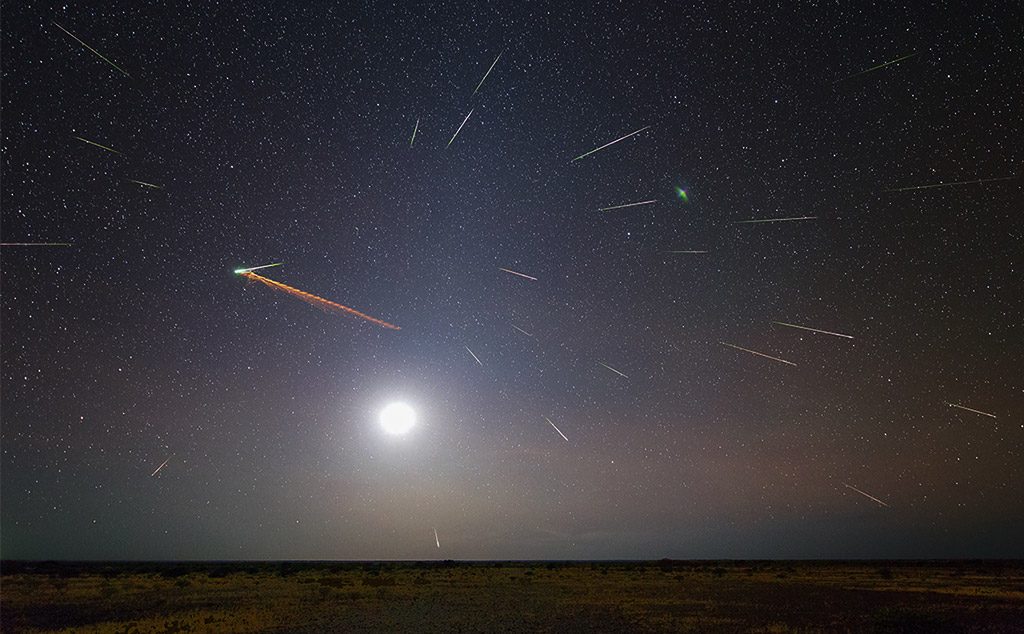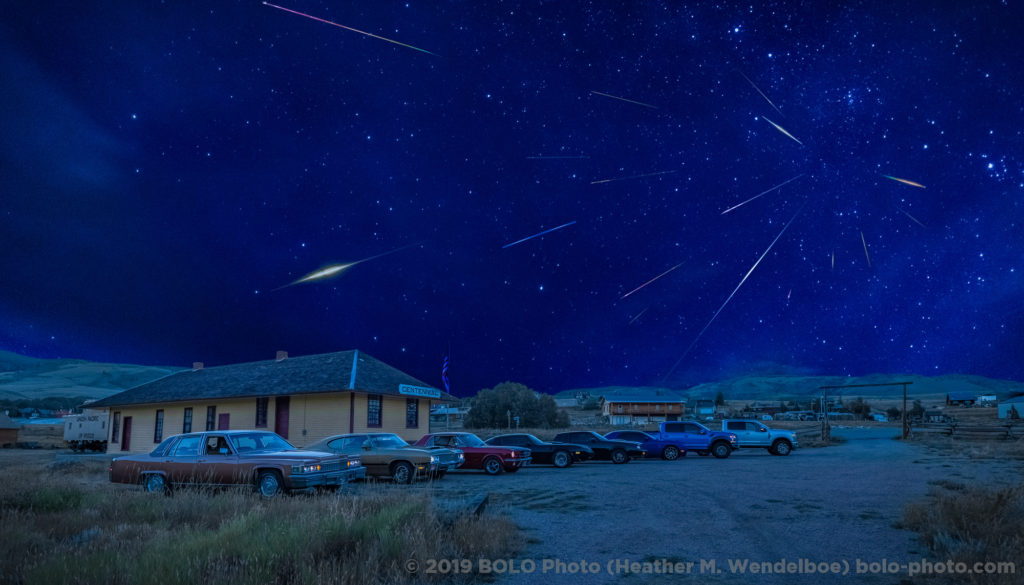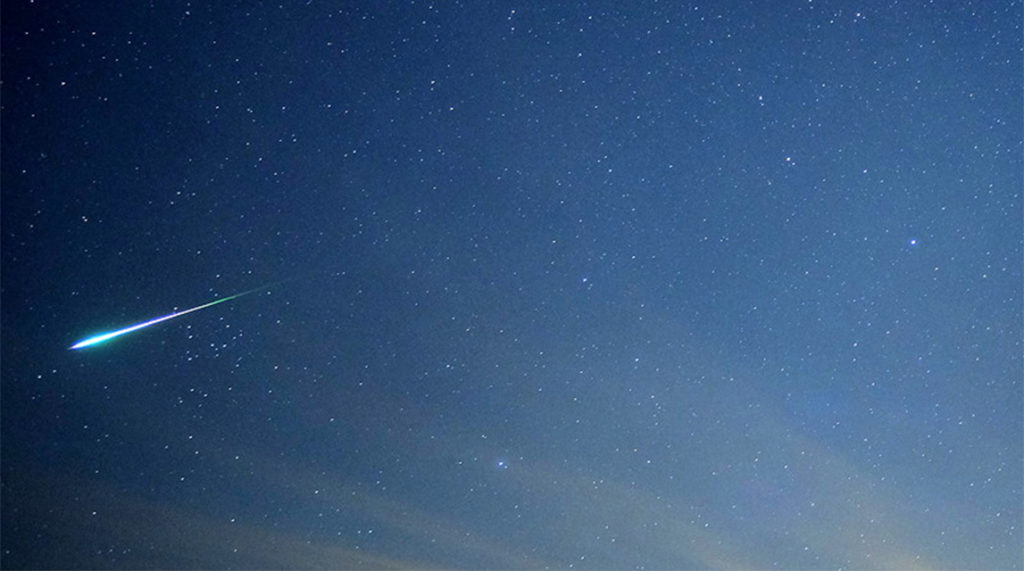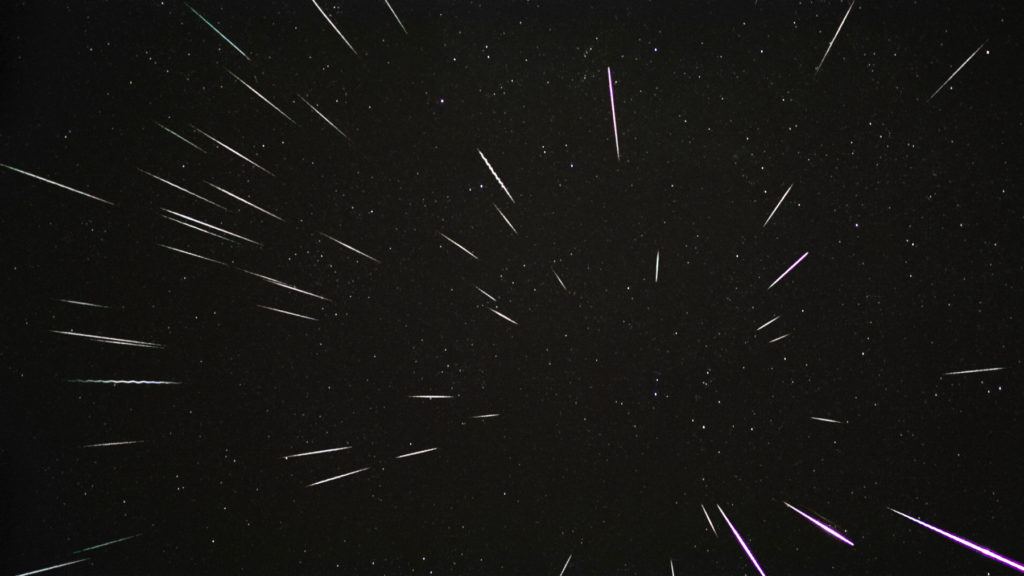As in all years, the activity of meteor showers largely depends on the phase of the moon. If the moon is more than one-half illuminated and above the horizon at the time of maximum activity, then the display will be muted compared to what could be seen under perfect conditions. Here we discuss the circumstances of major meteor shower events predicted for 2022, most notably discussing the effects of the moonlight on each display.
January
The Quadrantids are predicted to peak on 3 January 2022 at 20:40 Universal Time. This timing is favorable for Asia and high latitude areas of northern Europe. The moon is only one day past new, so the slender crescent will set near dusk and will not affect observing this display at all. This display has the potential of being the strongest meteor shower of the year as dark locations with the radiant high in the sky at maximum can see in excess of 100 Quadrantids per hour. These meteors are best seen during the early morning hours when the radiant lies highest in a dark sky.
April
The Lyrids are predicted to peak on 22 April 2022 at 19:00 Universal Time. Again, Asia is favored for this particular time but decent activity can usually be seen by most observers on this morning, regardless of their location. Unfortunately the moon will be a waning gibbous phase, rising just after midnight and reducing the number of meteors visible by 25-50 percent, depending on the transparency of your sky. Expect to see no more than 10 Lyrids per hour under these conditions. These meteors are also best seen during the morning hours when the radiant lies high in the sky.
April-May
The eta Aquariids will be the 2022 highlight for observers located in the Southern Hemisphere. This shower is expected to reach maximum activity on the morning of 6 May 2022. At that time the moon will be a waxing crescent and will set during the late evening hours. This is long before the radiant rises so there will be no lunar interference this year. Unlike most meteor showers, the eta Aquariids produce good rates for nearly a week centered on 6 May. Due to its location only 45 degrees from the sun, these meteors are only visible during the last couple of hours prior to dawn. They are best seen from the southern tropics where the longer nights allow the radiant to be seen at a higher elevation before dawn. Those viewing from dark sky sites in the Southern Hemisphere can expect to see around 30 meteors per hour from this source. From the Northern Hemisphere rates are usually less than 10 per hour.

Strong meteor activity from comet 73P/Schwassmann-Wachmann 3 may be visible near 5:00 Universal Time on 31 May 2022. This timing is favorable for southern North America, all of Central America, and northern South America. Northern North America has twilight all night long this time of year and the display will be hidden by the twilight sky. The moon is one day past new and will not interfere with observations. Unlike most meteor showers, this possible display will be best seen during the evening hours or early morning hours, depending on your longitude. Those located on the west coast of North America will have the advantage of viewing earlier in night. Many factors must fall into place for this event to occur. This shower is most often called the tau Herculids, but the expected radiant is located further west in the sky near the bright star known as Arcturus in the constellation of Bootes. For further reading on this possible display, refer to page 3 of WGN, the Journal of the IMO 49:1 (2021)

July-August
Another highlight for observers in the Southern Hemisphere will be the Southern delta Aquariids. This meteor shower is expected to peak on the morning of 30 July 2022. On that date the moon is two days past new and will set shortly after the dusk. These meteors are best seen during the mid-morning hours when the radiant is situated highest in the sky. These meteors are best seen from the southern tropics where up to 25 shower members may be seen each hour. Rates are usually less than 10 per hour as seen from the Northern Hemisphere.
The Perseids are expected to peak on 13 August 2022, near 1:00 Universal Time. Unfortunately this date coincides with the full moon and Perseid counts will be reduced by 50-75 percent, depending on the transparency of your sky. Despite the moonlight, this shower offers an entertaining display of meteors as many shower members are bright and colorful. While these meteors can be seen all night long from the Northern Hemisphere, they are best seen after midnight when the radiant lies higher in the sky. This display is visible from the southern tropics, but at a much reduced rate as the radiant skims the northern horizon just prior to dawn.
 Perseid meteor shower, due to its strong activity and its summe activity period for Northern hemisphere, is one of the most famous of the year. Credit: Heather M. Wendelboe
Perseid meteor shower, due to its strong activity and its summe activity period for Northern hemisphere, is one of the most famous of the year. Credit: Heather M. WendelboeOctober – November
The Orionids are expected to reach maximum activity on the morning of 21 October 2022. Like the eta Aquariids, these meteors are remnants of comet 1P/Halley and produce good rates for a week centered on 21 October. The moon on that date will be a waning crescent, rising between 2:00-3:00 local time. While this is the best time to witness these meteors, the slender crescent moon will offer no problems as long as you keep it beyond your field of view. These meteors are well seen from all areas except extreme southern latitudes, where daylight is 24 hours a day this time of year.
After November
This is a swarm year for the Taurids, which means there will be a higher percentage of bright meteors visible in late October and early November. The moon is new on 25 October, so the last week of October will be prime time for viewing these meteors. Rates will probably remain less than 10 per hour, but the appearance of enhanced fireball rates will be the main interest of these meteors. These meteors are visible all night long but are best placed around midnight when the radiant lies highest in the sky. This activity is visible from everywhere except extreme southern latitudes.
There are several Leonid outbursts predicted for 2022. The first is predicted to occur near 7:00 Universal Time on 18 November. This timing favors eastern North America and is expected to be weak, perhaps adding 5 meteors per hour to the Leonid count. This is from the 1600 dust trail. The second outburst is from the 1733 dust trail and is expected to be encountered between 6-6:30 Universal Time on 19 November. This timing also favors eastern North America where rates may reach 50-200 an hour for a short time. The last enhancement is from the 1800 dust trail and is expected around 15:00 Universal Time on 21 November. This timing favors the area of the Pacific Ocean such as Hawaii. The moon reaches its last quarter phase on 16 November. Therefore successful observations of these possible enhancements may be seen if you face in a direction that allows you to keep the half-illuminated moon out out your field of view. This activity is visible from everywhere except extreme southern latitudes.

The Geminids reach maximum activity on the morning of 14 December 2022. On this date the moon will be a waning gibbous phase, two days before last quarter. This will reduce activity by at least 25 percent, no matter where you face in the sky. It will still be a good show with many bright meteors, best seen near 2:00 local time when the radiant lies highest in the sky. Like the previous three showers, this activity is visible from everywhere except extreme southern latitudes.
 Geminid meteor shower is one of the more active and reliable meteor shower. Its activity is increasing from year to year and is dramatic for those who are not afraid of cold winter night observing sessions. Credit: Peter Slansky
Geminid meteor shower is one of the more active and reliable meteor shower. Its activity is increasing from year to year and is dramatic for those who are not afraid of cold winter night observing sessions. Credit: Peter SlanskyThe Ursids are expected to peak near 22:00 Universal Time on 22 December 2022. This timing is best for Europe and Asia. There may be other enhancements occurring near 10:21 UT and 14:22 UT on 22 December. Both enhancements favor North America. Ursid activity may rise to near 30 per hour for a short time during these periods. Ursid activity is invisible from the Southern Hemisphere as the radiant remains below the horizon during the nighttime hours. The moon is new on 23 December so there will be no interfering moonlight while viewing this display.
In conclusion, despite the fact that the Perseids and Geminids suffer significant problems with moonlight in 2022, there are still many opportunities to view interesting activity in 2022!
 American Meteor Society
American Meteor Society